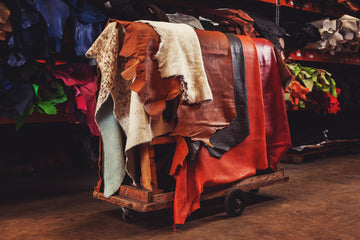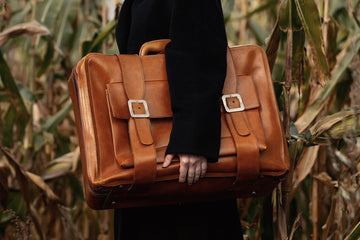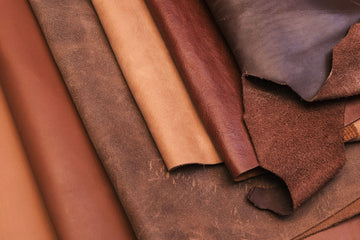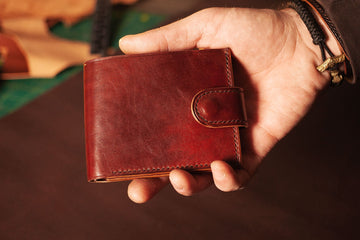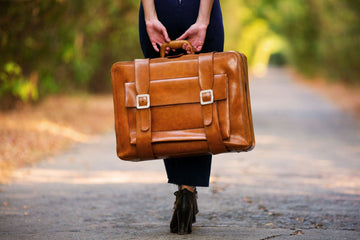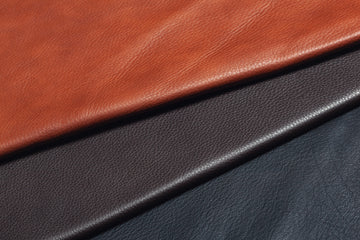Selecting the appropriate type of leather is essential when searching for an ideal leather bag. This guide will delve into the advantages and disadvantages of various types of leather, including cowhide, goatskin, camel, and buffalo leather, to assist you in choosing a material that aligns with your style preferences and requirements for making bags. Selecting the correct type of leather is crucial for making durable and stylish leather bags.
Key Takeaways
- Cowhide leather is favoured for its durability, flexibility, and natural appeal, making it a prime choice for making leather bags meant to last and gain character over time.
- Different types of leather, such as goatskin, camel, and buffalo, each offer unique characteristics like softness, lightweight strength, and robustness, catering to various aesthetic and functional preferences.
- The choice of leather grain—from full grain to genuine leather—is critical in determining a bag's quality, durability, and appearance. Full grain offers unmatched strength and a distinctive patina over time.
What Type of Leather Is Best for Leather Bags
The tale of a leather bag begins with the pristine, unprocessed hide. To ensure durability and strength, making bags involves selecting the right leather, such as full-grain, top-grain, or faux leather. Chapters of quality and durability define the evolution from beast's skin to chic clothing. Each stage, from the first tanning process and technique to the texture of the grain and selection of lining material, contributes fundamentally to crafting not just a vessel for carrying belongings but also an embodiment of a personal narrative.
Through our guide, you will acquire insight into selecting a leather bag that surpasses mere aesthetics to offer an impeccable amalgamation of functionality and fashion.
Understanding Leather Types
Venturing into the varied realm of animal leather, one will find a range of goat leather options.
- The strong and dependable cowhide
- The flexible goatskin
- The tough camel hide
- The durable buffalo skin.
Every type of leather offers distinctive qualities and visual appeal. Cowhide is remarkably esteemed within the industry for its outstanding durability and innate elegance.
Investigating these various types of split leather indicates that choosing your leather extends beyond mere taste. It's about defining the fundamental character of your bag and ensuring the best material for making bags.
Cowhide Leather
Cowhide leather is preferred by artisans who make premium leather bags designed to endure. This type of leather earns its acclaim for being exceptionally durable, boasting a unique natural texture and pattern that imbues each item with distinctive character as it reflects life's various marks.
The purposeful design of cowhide leather bags ensures they are resistant to scratches and scrapes, enabling them to accompany you through many years while developing even more personality over time.
Goatskin Leather
Real leather crafted from goat skins, commonly referred to as goatskin or goat leather, retains the naturally occurring lanolin that ensures the skins' suppleness and pliability. This attribute makes it ideal for making leather bags, providing a durable, water-resistant protective layer for your possessions despite its deceivingly lightweight.
The distinctive pebbled texture inherent in goats' hair and skin imparts an exotic flair to bags and wallets made from this material. It enhances the visual appeal and endows these items with a tangible, equally gratifying quality, whether felt by hand or seen by the eye.
Camel Leather
The highly durable and unique texture of camel leather reflects the resilience inherent in creatures from arid landscapes. Its robust yet featherlight nature renders camel leather an optimal material for making leather bags. These bags offer a narrative of survival and durability and cater to individuals in pursuit of accessories that embody the essence of exploration and permanence.
Buffalo Leather
Crafted from hides that can be up to three times as thick as cowhide, buffalo leather is ideal for making leather bags due to its distinctive and rich grain pattern. This pattern imparts durability and a unique appearance. Leather bags from this material exhibit increased structure and make an impressive statement in any environment.
Despite their heavier construction, buffalo leather bags are designed for longevity. They effortlessly endure daily wear and tear, showcasing animal leather's resilience in everyday use.
Importance of Leather Grain
Exploring the structure of leather reveals that the grain, essentially the skin of the hide, is crucial for a bag's resilience and aesthetic appeal, especially when making leather bags. The calibre of grain leather significantly influences how long-lasting and attractive leather bags will be. Ranging from esteemed full-grain to widely available top-grain through to humble genuine leathers and suede types, it is within this very grain that we find an embodiment of robustness interwoven with style – a testament to where each piece's unique story begins.
Full Grain Leather
At the zenith of the range of leather choices lies full grain leather, a premium material that retains the hide's inherent imperfections, bestowing upon the fabric of every bag a distinctive pattern. This uppermost segment of the hide remains untouched by sanding or buffing processes, maintaining its natural integrity and robustness. Such quality guarantees endurance and enables the development of a lustrous patina as time progresses—a clear signifier of genuine luxury.
Top Grain Leather
While top-grain leather isn't as durable as full-grain leather, it compromises high quality and cost-effectiveness. It undergoes an operation where the hide's uppermost layer is smoothed out by sanding away flaws, leading to a more supple and consistent surface.
This popular type of leather has become a favoured choice for individuals seeking upscale leather bags but at a more accessible price point.
Genuine Leather
Genuine leather is often misconceived as the highest quality of leather. It falls lower on the quality spectrum. This type of leather is produced from the interior of multiple layers of animal hide and has enhancements to its surface for aesthetic purposes. Though it is a budget-friendly choice, the genuine level does not offer the lasting durability or luxurious feel of more premium leathers, making it unsuitable for daily-use bags. On another note, faux leather provides an accessible and morally considerate substitute for individuals who opt against using genuine leather or animal hide-derived products.
Suede Leather
Recognisable for its velvety, soft texture, suede leather offers a distinctive touch sensation that sets it apart from other types of leather. Yet this delicate surface makes it more susceptible to damage from environmental factors and necessitates greater effort to preserve its aesthetic.
Suede leather bags are indeed fashionable accessories, but given their vulnerability, they should be considered for use on special occasions rather than subjected to the rigours of daily wear.
Tanning Processes and Their Impact
In the transformational voyage of making leather bags, rawhide metamorphoses into refined leather, attaining its signature texture and durability as well as its ecological impact. Various methods, including time-honoured vegetable-tanned techniques to contemporary chrome and aldehyde treatments, bestow upon the leather unique characteristics that influence an informed consumer's choice to buy leather elsewhere.
Vegetable Tanned Leather
Soaked in plant and bark extracts, vegetable-tanned leather acquires a deepening rich patina as it ages. Appreciated for its environmentally friendly process and soft texture, this leather offers tactile pleasure and ecological consideration.
Chrome Tanned Leather
Using chromium salts in the chrome tanning process rapidly imparts flexibility and water resistance to leather, though it does carry a heavier chemical footprint.
This treatment produces supple, pliable, and resilient leather, making it ideal for crafting bags designed to endure daily wear and tear.
Aldehyde Tanned Leather
Aldehyde-tanned leather offers a sustainable alternative to chrome tanning, producing a supple and flexible material that is also hypoallergenic. This caters to consumers who value comfort while maintaining an environmentally friendly stance.
The Role of Lining in Leather Bags
Underneath a bag's leather lies an often overlooked aspect: its lining. This key feature not only maintains the bag's shape and structure but also safeguards what's inside against damage from the coarse interior side of the leather. By isolating and strengthening, a properly selected lining can enhance a bag's durability, which is crucial in making leather bags.
The selection process for linings is integral to creating a premium leather bag. Whether opting for durable canvas or plush cotton, the premium choice of each material plays an essential role in both the functionality and craftsmanship of these soft-hide containers.
Canvas Lining
Numerous leather bags incorporate canvas lining, which offers essential support for carrying everyday items. The lining's light and supple qualities contribute to maintaining the bag's durability while allowing it to adjust shape according to what it holds inside.
Cotton Lining
The addition of a cotton lining provides a top layer of breathability and comfort to the bag, ensuring it stays fresh and pleasant to handle. This timeless selection enhances the inherent qualities of leather by offering a soft, eco-friendly layer for your items inside.
Unlined Bags
Unlined leather bags reveal the hide's charm, allowing a direct view of the leather's authentic, natural grain. These lighter and more airy bags embody simplicity but require greater care to maintain a pristine, unblemished interior.
Choosing the Best Leather for Your Needs
Possessing a comprehensive knowledge of the nuances of various leather styles is essential when making leather bags, as the crucial task is to match your specific requirements with an ideal type of leather. If you're pursuing a durable daily ally to create a distinguished accessory for significant events or a reliable travel associate, finding the perfect leather bag means marrying suitable material quality, expert craftsmanship, and intended function.
Best Leather for Everyday Use Bags
To endure the endless tempo of daily activities, bags and purses crafted from cowhide and buffalo leather are not merely accessories. They're indispensable implements. Thanks to their solid composition, these materials guarantee that the durability required for perpetual usage is met, allowing them to stand up reliably daily.
Best Leather for Luxury Bags
When prioritising luxury and elegance, full—grain leather—especially that sourced from calfskin—is the premium selection. This type of natural-grain leather adds a unique sophistication to fashion accessories and evolves to create a patina over time, narrating tales of grandeur and diligent maintenance. Consequently, it's the preferred material for high-fashion bags where style is paramount.
Best Leather for Travel Bags
The traveller with a wandering heart seeks a durable and light bag. Goatskin and lambskin leathers meet these requirements, as their natural resilience combined with a light profile ensures ease for the journeyer who values style and practicality.
Best Leather for Leather Satchels
Full-grain and top-grain leather are ideal for a classic leather satchel that perfectly blends practicality with elegance. These different types of leather provide a durable and chic option for a bag, making it an accessory that frequently serves as an expression of individual style while also meeting functional needs.
Frequently Asked Questions:
Why is Full-Grain Leather Considered the Best for Bags?
Grain leather, known for its robustness and ability to develop a unique patina that augments its aesthetics over time, is deemed the premier choice of materials for bags. Full-grain leather maintains the hide’s inherent textures and distinctive markings, ensuring each bag is one-of-a-kind in appearance.
Can Goatskin Leather Be a Good Choice for Everyday Bags?
Certainly, bags crafted from goatskin leather are an excellent selection for daily use thanks to their soft texture, lightness, resistance to water, robustness, and adaptability. These characteristics render it apt for enduring regular usage.
What is the Difference Between Chrome-Tanned and Vegetable-Tanned Leather?
The primary distinction between vegetable-tanned and chrome-tanned leather lies in the process of tanning: vegetable tanning employs natural oils and plant-based tannins vegetable tanning, leading to an eco-friendly product that gains a distinctive patina as it ages, whereas chrome tanning utilises chromium salts, which impart greater flexibility and resistance to water in the leather.
Are Unlined Leather Bags Better Than Lined Ones?
The choice hinges on one’s taste and the purpose for which the bag is intended. Unlined bags display the leather's natural texture, although they have more structure and may present more challenges when it comes to cleaning. On the other hand, bags with linings provide additional protection for whatever is inside and can enhance the bag's form and durability.
How Do I Choose the Best Leather for a Luxury Handbag?
Opt for full-grain leather, particularly calfskin, when selecting a luxury handbag because it provides not only a refined smoothness but also robust durability and gracefully matures into an exquisite patina with time. This makes it the superior selection for those seeking both high quality and luxury in appearance.
How to Buy the Best Leather to Make Bags
When looking for the perfect leather bag, it is essential to understand what types of leather are available and their grains and consider variables such as budget, looks and sustainability. We recommend cowhide leather, vegetable tanned or full grain leather versions for longevity and pleasing aesthetic qualities. Selecting a reliable inner lining material is essential.
Obtaining good quality tanned skins from reliable internet merchants guarantees that your chosen bag will be around for many years with proper maintenance techniques involved, too.
🔗 Buy leather for leather bags
Please get in touch with us if you have any questions about the different types and grades of leather used for making bags. We are here to provide you with a better understanding of each type of leather and help you choose the right one that will not only enhance the aesthetics of your bag but also ensure its longevity.
